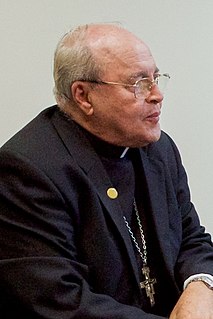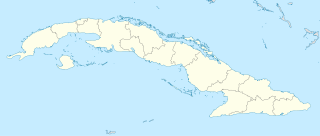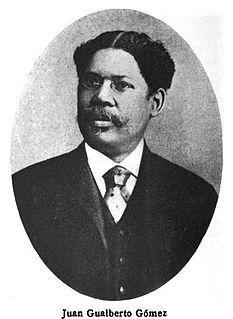
The Democratic Solidarity Party was a political liberal party in Cuba. Although changes to the Cuban constitution in 1992 decriminalized the right to form political parties other than the Communist Party of Cuba, these parties are not permitted to campaign or engage in any public political activities on the island. The Democratic Solidarity party describes itself as "an organization from within Cuba promoting democracy and the respect for human rights by the peaceful route." The President of the party is Fernando Sánchez López. The party is a full member of Liberal International.
This article gives an overview of liberalism in Cuba. It is limited to liberal parties with substantial support, mainly proved by having had a representation in parliament. The sign ⇒ means a reference to another party in that scheme. For inclusion in this scheme it isn't necessary so that parties labeled themselves as a liberal party.

Lt. General José Antonio de la Caridad Maceo y Grajales was second-in-command of the Cuban Army of Independence.

Matanzas is the capital of the Cuban province of Matanzas. Known for its poets, culture, and Afro-Cuban folklore, it is located on the northern shore of the island of Cuba, on the Bay of Matanzas, 90 kilometres (56 mi) east of the capital Havana and 32 kilometres (20 mi) west of the resort town of Varadero.

Jaime Lucas Ortega y Alamino is the Archbishop Emeritus of the Archdiocese of Havana and a Cardinal of the Catholic Church. He is the second Cuban elevated to Cardinal. He later stepped down from his see on April 26, 2016.
The Pact of Zanjón ended the armed struggle of Cubans for independence from Spain that lasted from 1868 to 1878, the Ten Years' War. On February 10, 1878, a group of negotiators representing the rebels gathered in Zanjón, a village in Camagüey Province, and signed the document offered them by the Spanish commander in Cuba, General Arsenio Martínez Campos, who had arrived in the Spanish colony two years earlier and immediately sought to come to terms with the rebels. The end of hostilities did not represent a military victory for either side, but a recognition by both sides of their "mutual exhaustion".

Juan Gualberto Gómez Airport, formerly known as Varadero Airport, is an international airport serving Varadero, Cuba and the province of Matanzas. The airport is located 5 km from the village of Carbonera, closer to the city of Matanzas than to Varadero. The closest airport to Varadero is Kawama Airport. In 2009, the airport handled 1.28 million passengers, making it the second busiest airport in Cuba after José Martí International Airport in Havana.

Manuel Rodulfo Tardo was a Cuban artist. He studied at the Escuela Nacional de Bellas Artes “San Alejandro”, Havana, Cuba, together with Juan Esnard Heydrich y José Francisco Cobos,and at The Sculpture Center, New York, U.S.A. One of his mentors was the Cuban sculptor Juan José Sicre. He was a painter as well as a sculptor.
The Cuban National League was a political party in Cuba. The league was one of two political groupings that emerged from the Junta Patriótica in Havana in March 1899.
The Republican Party of Havana was a political party in Cuba. The party was founded in the end of 1899. It was led by Dr. Domingo Méndez Capote. Prominent party members included Mario García Menocal, Eugenio Sánchez Agramonte, Fernando Freyre de Andrade, Manuel María Coronado, Manuel Despaigne and Juan Gualberto Gómez.
The Federal Republican Party of Las Villas was a political party in Las Villas, Cuba. The party was founded in 1899 by the provincial governor José Miguel Gómez and Carlos Mendieta y Montefur. Pelayo García Santiago was the president of the party. Prominent party members included General José B. Alemán, Dr. Rafael Martínez Ortíz, General José de J. Monteagudo, José Manuel Berenguer, Francisco López Leyva, Lic. Benito Besada, José L. Robau, Eduardo Domínguez, Dr. Orestes Ferrara and Enrique Villuendas.
The Cuban National Party was a political party in Cuba. At the very beginning of the 20th century, it was one of the three main political parties on the island. The party favoured independence for Cuba.
Municipal elections were held in Cuba on June 16, 1900. The elections were held under the auspices of the U.S. Military Government with a system of restricted suffrage. 7% of the Cuban population took part in the polls, which saw some important victories for pro-independence sectors.

Kawama Airport is an airport serving Varadero, in the Matanzas Province in Cuba.

Juan Gualberto Gómez Ferrer was an Afro-Cuban revolutionary leader in the Cuban War of Independence against Spain. He was a "close collaborator of [José] Martí's," and alongside him helped plan the uprising and unite the island's black population behind the rebellion. He was an activist for independence and a journalist who worked on and later founded several pivotal anti-royalist and pro-racial equality newspapers. He authored numerous works on liberty and racial justice in Latin America as well.

Pedro Betancourt Dávalos (1858–1933) was a doctor, a major general and Cuban revolutionary in the Cuban War of Independence, a diplomat, a secretary of agriculture, a politician and a father.
The following is a timeline of the history of the city of Matanzas, Cuba.











